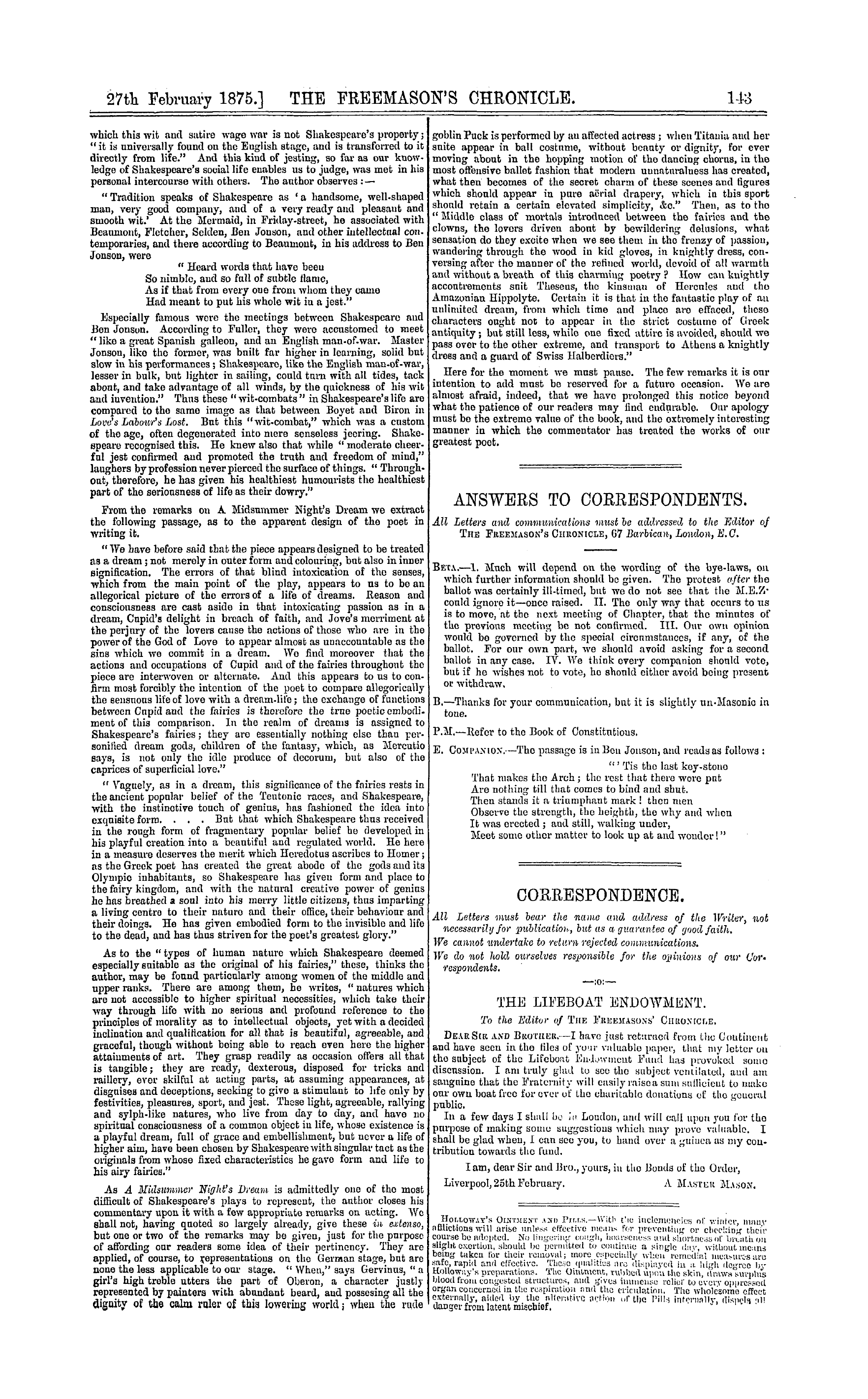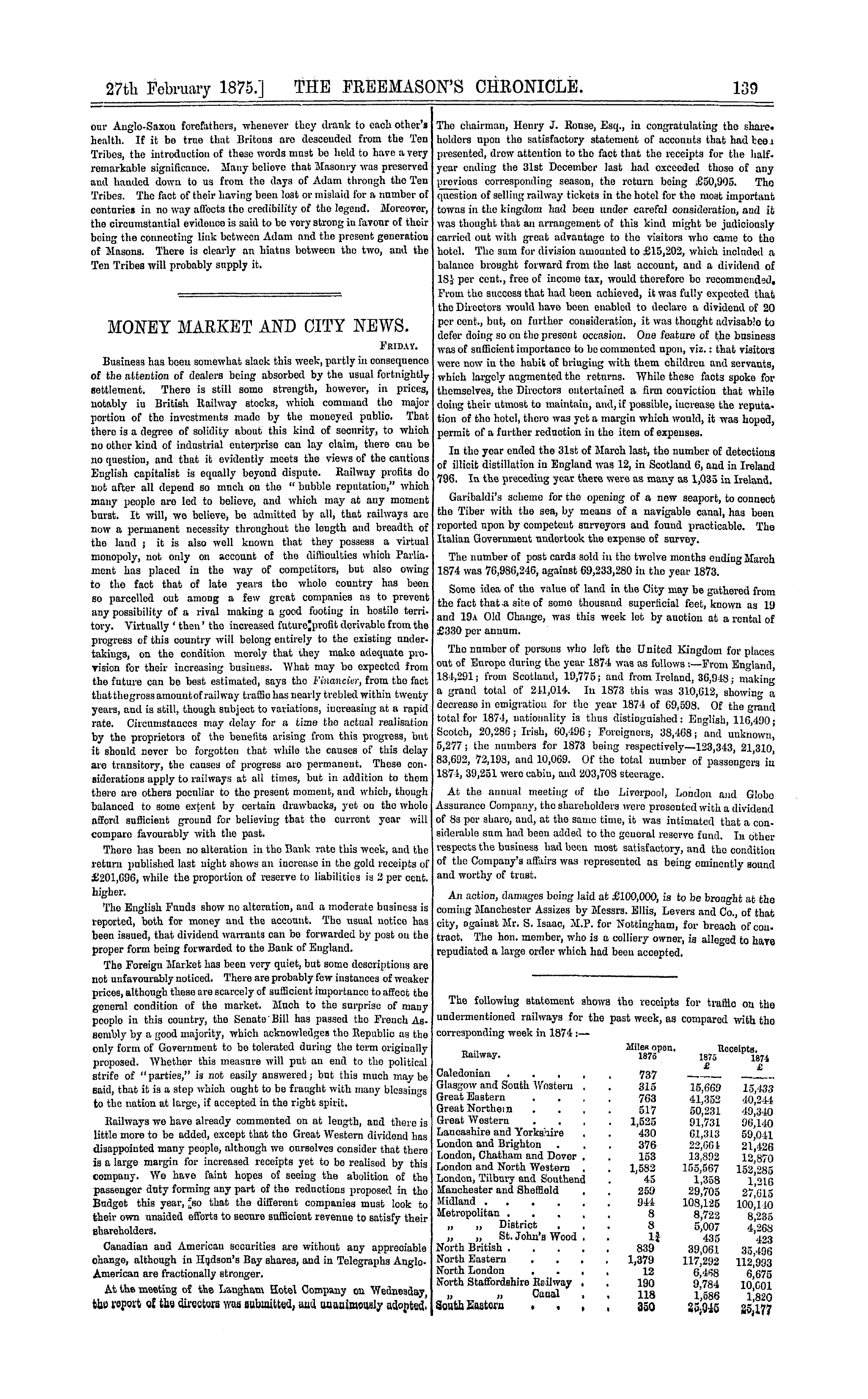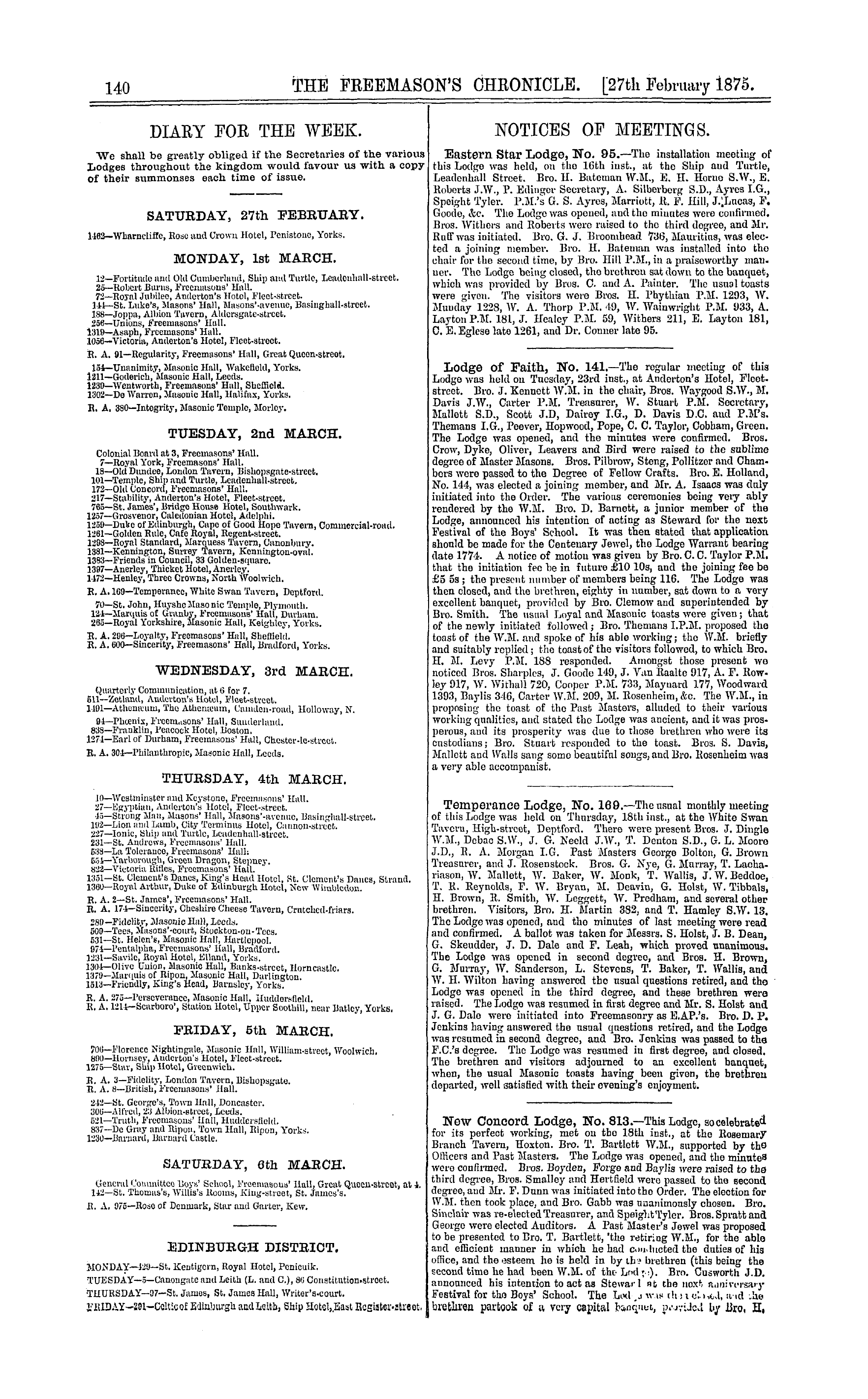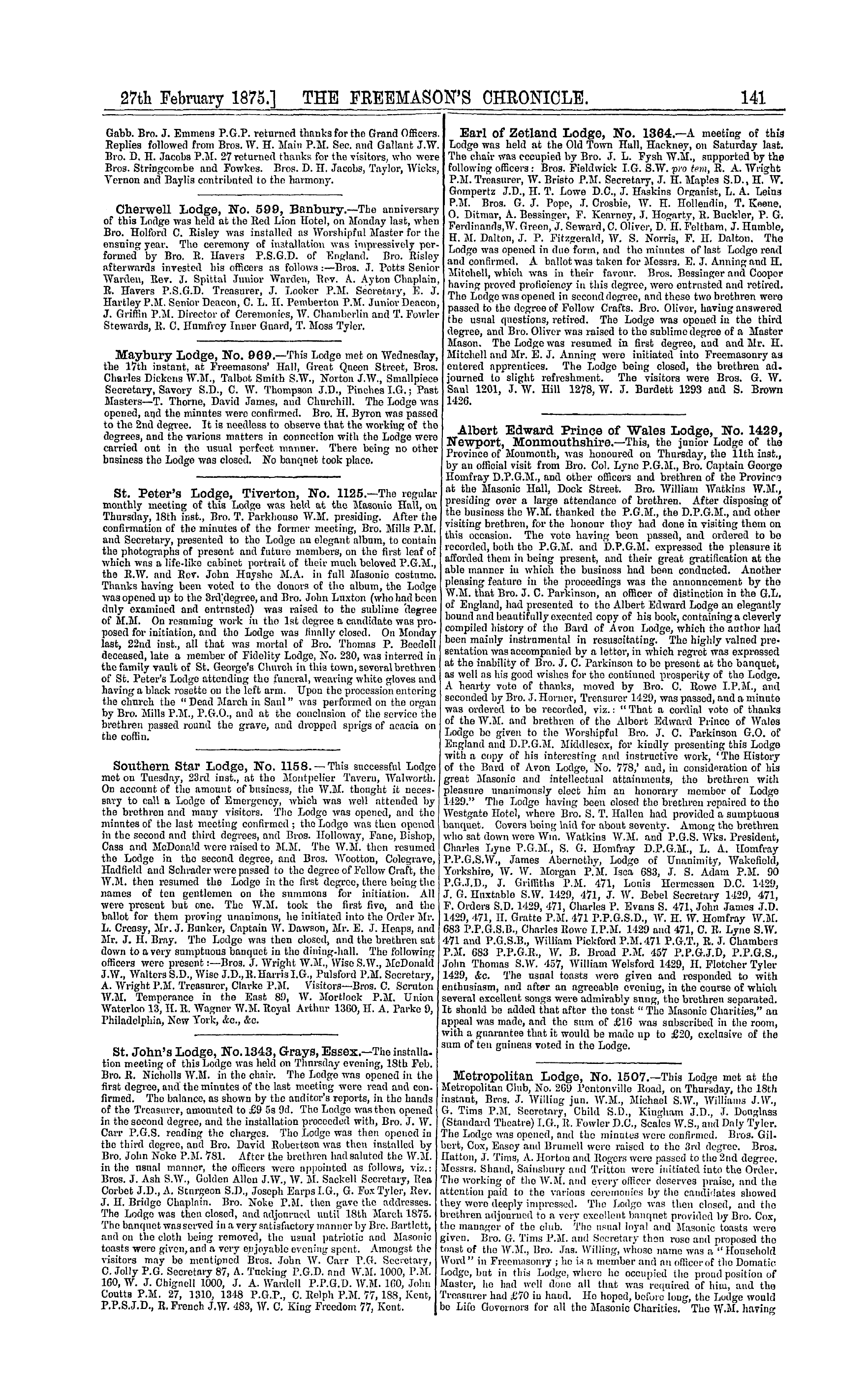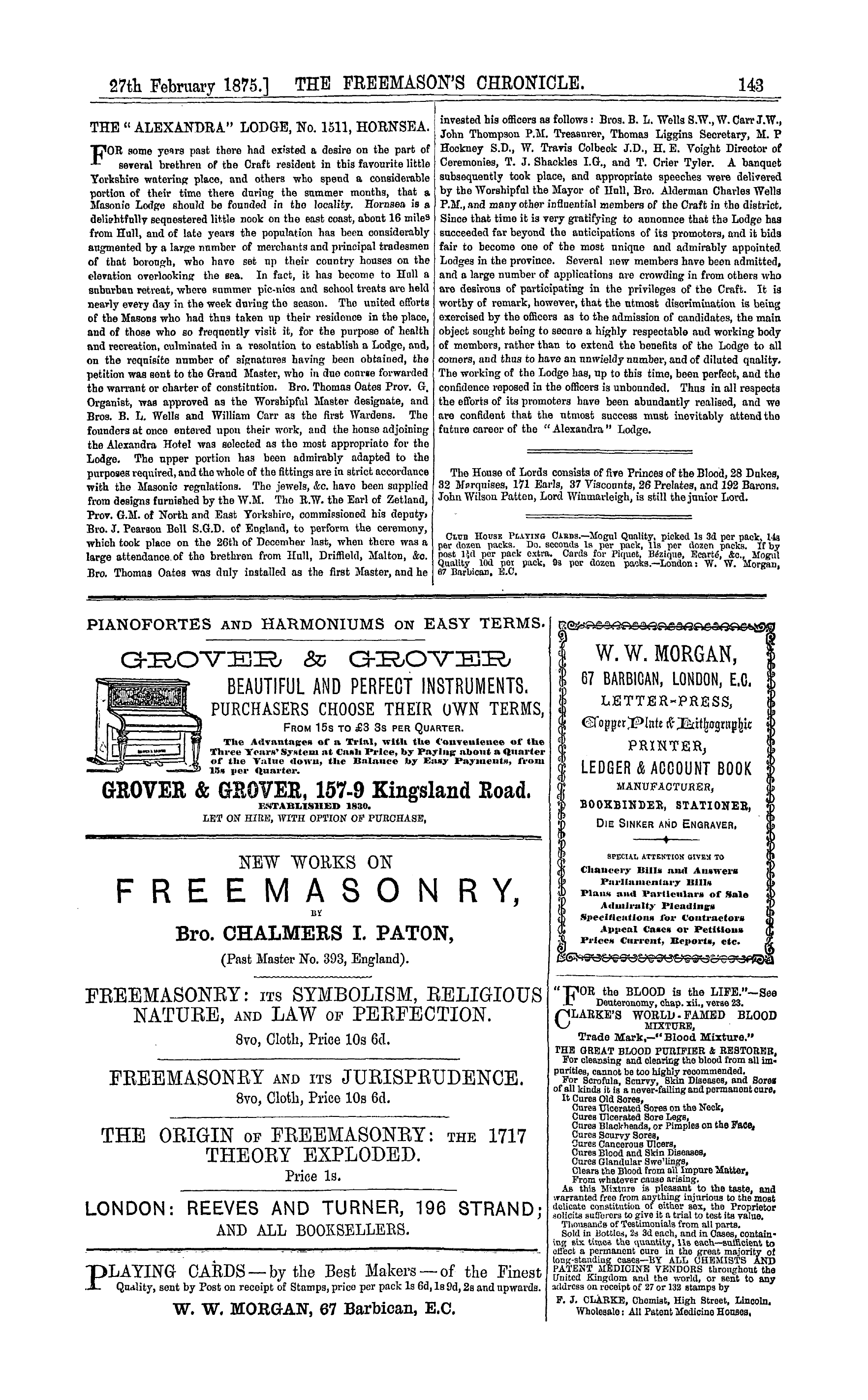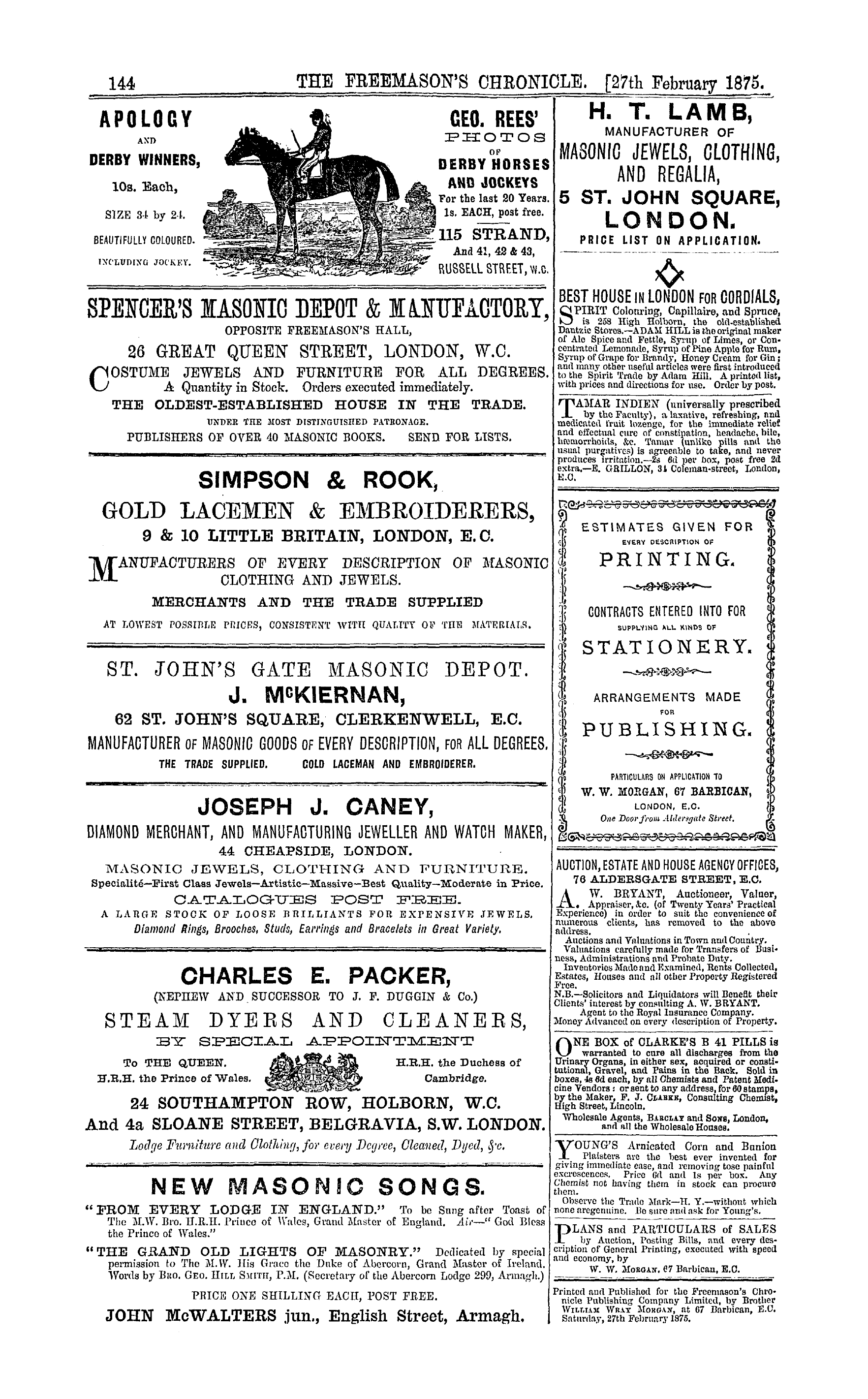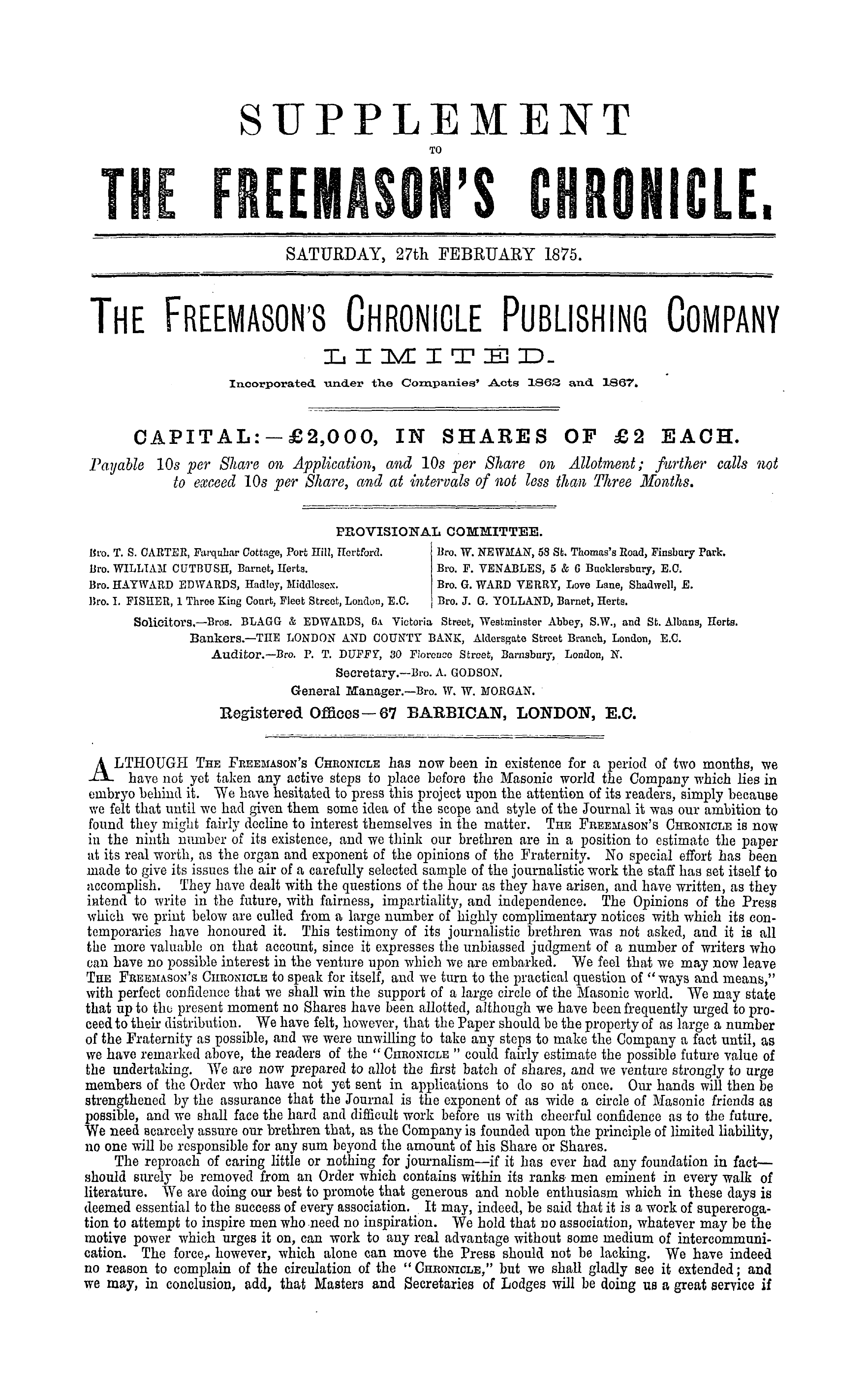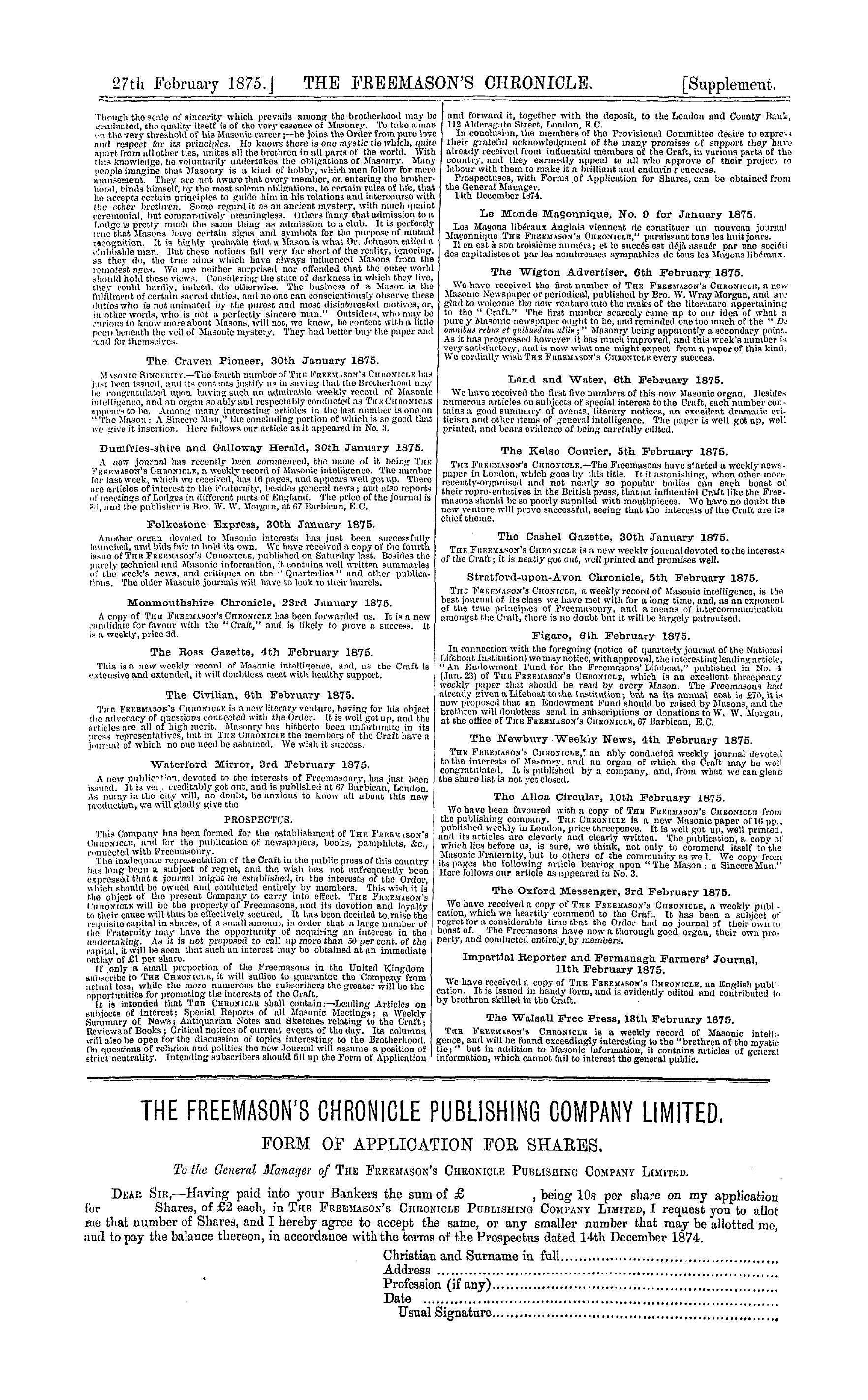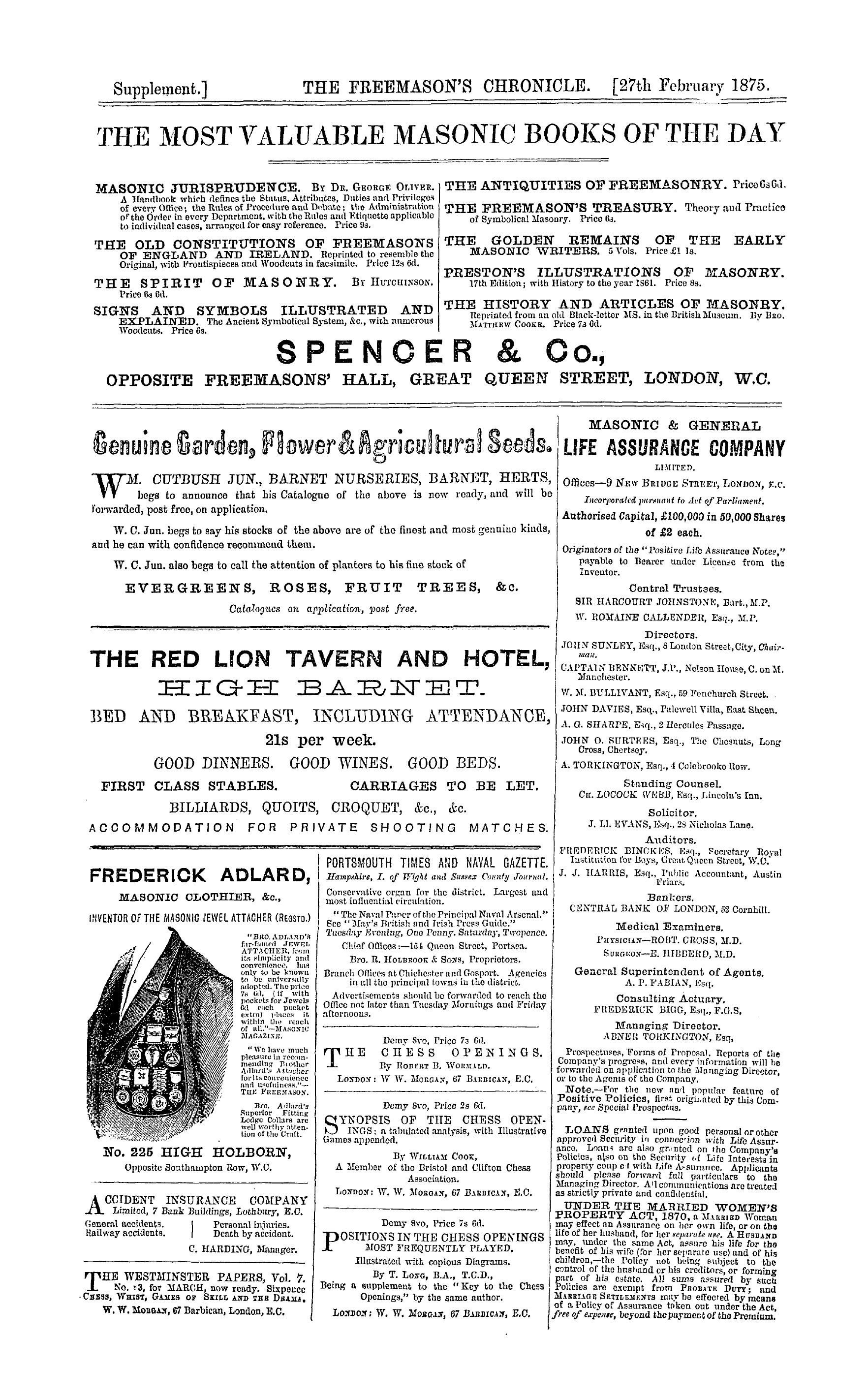-
Articles/Ads
Article A FEW WORDS ON AMERICAN MASONRY. ← Page 2 of 2 Article DIONYSIAN ARTIFICERS.* Page 1 of 2 Article DIONYSIAN ARTIFICERS.* Page 1 of 2 →
Note: This text has been automatically extracted via Optical Character Recognition (OCR) software.
A Few Words On American Masonry.
he has shown this respect to his order , he fulfils all hi ? obligations either to the society in which he moves or Society in general . 2 . The question of parade and show may , as Bro .
Hughan suggests , " resolve itself into a matter of opinion . " Doubtless , all people will not hold the same views as to what constitutes ostentations " parade , glitter , show and extravagance . " There is this to be said in favour of OUT
view . The Americans love display , not m things Masonic only , but in general . Love of show , of finery , of rich jewelry , of high-sounding titles is an American " proclivity , " on which we are not the only journal that has commented freely . Englishmen on the other hand are naturally averse from show .
3 . On the subject of Masonic Chanties in the United States we may remark , that we never imagined , nor was it our intention to suggest , that American Masonry did not lend itself to the deeds of Charity . The tenour of our argument was simple enough . American Masons love fine
architecture and ostentatious display , hut where , by comparison with this outward show , is the love for Masonic Charity ? Where are the institutions for distressed Masons , for orphans , for widows ? Bro . Hughan cites three particular cases , and no doubt , as he says , had he the
time , he could instance many more . All honour to the Masons of Kentucky , of Pennsylvania , of Louisiana for the splendid efforts they have made in this direction ! But it must be borne in mind , that in the "United States there are said to be thirty-seven Grand Lodges , and considerably
over half-a-million of brethren . To quote Bro . Hugban ' s words , " In the United States alone there are about eight times as many subscribing members as in this country . " In England—we submit the statement with all respect to Bro . Hughan and our readers generally—we have less gorgeous
temples , loss " parade , glitter , show and extravagance , " than are to be found in the United States , but the three annual festivals for the Benevolent Institution and the Institution for Bovs and Girls respcctivelv vield an aggregate sum of little short of £ 20 , 000 or 100 , 000 dollars . This , be it
remembered , represents only the sum of the collections at these annual festivals , apart from other contributions from the Craft during the rest , of the year , and apart likewise from other sums dispensed in charities . We have taken no account of local efforts in the same beneficent work , nor have
we referred to the invested funds of the Benevolent and Girls' Institutions . One more fact and we have done . In the Report of the Boys' Institution , published last June , the building expenditure for that Institution , to 31 st December
18 / 0 , is stated at over £ 47 , 116 ; and in the account for 1873 there appears a further expenditure just exceeding £ 2 , 314 . Here , then , wo have a sum of nearly £ 50 , 000 , or 250 , 000 dollars , expended on behalf of this one school .
Having thus justified , as we believe , our previous statements , it only remains for us to add that we shall sincerely welcome every evidence of Masonic charity in the United States . We do not doubt they will fulfil generally , as Bro . Hughan has shown they do in specific instances ,
their duties in this respect both as Men and Masons . But we cannot say we think they have done all it lies in their obligation to do , as yet . There is this to be said on behalf of American Masonry , cases of pressing distress are immediately relieved .
Dionysian Artificers.*
DIONYSIAN ARTIFICERS . *
THIS little work may be regarded as , so to speak , the Holy Grail of Masonry . Although it was written only forty-five years ago , it is so scarce that the bibliomaniac may almost look in vain for a copy of it . The late Dr . Crucefix , the projector of the Royal Masonic
Benevolent Institution , made diligent search for the work during twelve years , and died without success . He had the highest opinion of its value . Mr . R . Spencer sought in vain for it from 1848 until 1872 , and we are indebted to the kindness
of his son , Mr . W . Spencer , for the loan of the copy which lies before us . It is , we believe , the only work in which are summarised the proofs of the resemblance of Freemasonry to the mysteries of Dionysus . The author accurately
Dionysian Artificers.*
quotes the authorities for his facts and opinions , and to this circumstance , as Avell as to the clear and concise style in which he has condensed a vast mass of unique information , the work owes much of its fame . In these days , when a taste for speculative Masonry has been excited by the
labours of modern philologists and archaeologists , a reprint of the work would be of the greatest value to the student . We are proud to admit that a few learned and enthusiastic brethren are toiling with us in the congenial field of speculative research , and to those who desire to trace for
themselves the fragments of the Dionysian mysteries , which are scattered through the literature of Greece and Rome , this little work would prove an invaluable guide . Mr . Da Costa , the author , must have been a man of profound learning , and of large and liberal ideas . His fragmentary sketch was
written at a time when anything like a just appreciation of the mythology or religion of ancient Egypt or Greece was very rare . It was the common opinion of men who passed for authorities that the system of ethics , which guided the
wonderful people who flourished for so many ages ago on the banks of the Nile , Avas a degraded one , that their religion was a jumble of immoral fables and pseudo science , and that the gross degradation into which the Hellenic tribes sank was to be ascribed to the influence of their so-called
superstitions upon the minds of the people . Even in these days of comparative toleration and enlightenment we occasionally come across a writer who is ignorant enough to confess his belief in the gross " paganism " of the ancient Egyptians , and the pulpit still resounds with the fierce
denunciations of their supposed spiritual darkness . Mr . Da Costa traces the ancient sun worship to a people living as far north as latitude 66 ° , in fact to the Atlantides , and thus raises the question which has so long troubled the minds of the learned , as to whether an island or continent , once the
seat of civilisation , has or has not been submerged by the sea . Atlantis is assumed by some writers to be the continent of America , and the significant fact that in Mexico archa 3 ological remains and a system of picture writing , similar to that which prevailed in Egypt , have been found , would
appear to give some colour to the theory . That sun worship originated with a people where the great luminary of day was but a fitful visitant would appear to be a feasible idea , and its development southward in America and Asia may possibly be ultimately traced . Scythia , that mystic
region of the ancient Greeks , appears to the author to be the original seat of this worship . To the Greeks Scythia was regarded as the earth ' s remotest boundary , and readers
of iEchylus will remember that he lays the scene of the binding and punishment of the fabled Prometheus in this portion of the world . It was there that the great and benevolent Titan was fixed to the rock . It was there that
the bird of Jove made daily onslaught upon the helpless teacher of the arts and sciences . The suggestion that Zoroaster was a Scythian can , we think , be scarcely supported by facts , but we readily agree with the writer that the teachings of this great man may have been
imported from a northern clime . That Egypt was indebted to a people living east of the Nile for its religious ceremonies is , we think , a fact that will sooner or later be clearly established . That the Egyptians were Asiatic admits of no doubt . The type of face which is so familiar to all
Egyptologers is not in the remotest degree African in its general outlines . The Egyptian physique is slight , and affords a singular contrast to that of the lusty negro , whose muscular frame and low order of intelligence mark him as a being of an entirely different race . We regard the
Egyptians as colonists who , at a remote period , settled on the banks of the Nile , bringing with them the civilisation of Asia , and the germs of a reli gion which afterwards assumed a distinct type of its own . The Osirian story , the earliest known myth of Egyptian
theology , which may have been derived from the Persians , lies at the root of these Eleusinian rites , which are better known to most Masonic readers as the mysteries of Dionysius or Bacchus . These consisted in the study of the sciences and useful arts , united with theology and ethics ,
and were communicated by cyphers or symbols . Candidates for admission were required to be of pure life , and were rigidly examined , by properly appointed persons , before initiation . The pith of the doctrine taught may be
summed up in a few words . The future state of the soul , and future rewards and punishments ; indeed so high an estimate had the teachers of the value of the spiritual life , that the union of the soul with the body was regarded as its death , and the death of the body its resurrection .
Note: This text has been automatically extracted via Optical Character Recognition (OCR) software.
A Few Words On American Masonry.
he has shown this respect to his order , he fulfils all hi ? obligations either to the society in which he moves or Society in general . 2 . The question of parade and show may , as Bro .
Hughan suggests , " resolve itself into a matter of opinion . " Doubtless , all people will not hold the same views as to what constitutes ostentations " parade , glitter , show and extravagance . " There is this to be said in favour of OUT
view . The Americans love display , not m things Masonic only , but in general . Love of show , of finery , of rich jewelry , of high-sounding titles is an American " proclivity , " on which we are not the only journal that has commented freely . Englishmen on the other hand are naturally averse from show .
3 . On the subject of Masonic Chanties in the United States we may remark , that we never imagined , nor was it our intention to suggest , that American Masonry did not lend itself to the deeds of Charity . The tenour of our argument was simple enough . American Masons love fine
architecture and ostentatious display , hut where , by comparison with this outward show , is the love for Masonic Charity ? Where are the institutions for distressed Masons , for orphans , for widows ? Bro . Hughan cites three particular cases , and no doubt , as he says , had he the
time , he could instance many more . All honour to the Masons of Kentucky , of Pennsylvania , of Louisiana for the splendid efforts they have made in this direction ! But it must be borne in mind , that in the "United States there are said to be thirty-seven Grand Lodges , and considerably
over half-a-million of brethren . To quote Bro . Hugban ' s words , " In the United States alone there are about eight times as many subscribing members as in this country . " In England—we submit the statement with all respect to Bro . Hughan and our readers generally—we have less gorgeous
temples , loss " parade , glitter , show and extravagance , " than are to be found in the United States , but the three annual festivals for the Benevolent Institution and the Institution for Bovs and Girls respcctivelv vield an aggregate sum of little short of £ 20 , 000 or 100 , 000 dollars . This , be it
remembered , represents only the sum of the collections at these annual festivals , apart from other contributions from the Craft during the rest , of the year , and apart likewise from other sums dispensed in charities . We have taken no account of local efforts in the same beneficent work , nor have
we referred to the invested funds of the Benevolent and Girls' Institutions . One more fact and we have done . In the Report of the Boys' Institution , published last June , the building expenditure for that Institution , to 31 st December
18 / 0 , is stated at over £ 47 , 116 ; and in the account for 1873 there appears a further expenditure just exceeding £ 2 , 314 . Here , then , wo have a sum of nearly £ 50 , 000 , or 250 , 000 dollars , expended on behalf of this one school .
Having thus justified , as we believe , our previous statements , it only remains for us to add that we shall sincerely welcome every evidence of Masonic charity in the United States . We do not doubt they will fulfil generally , as Bro . Hughan has shown they do in specific instances ,
their duties in this respect both as Men and Masons . But we cannot say we think they have done all it lies in their obligation to do , as yet . There is this to be said on behalf of American Masonry , cases of pressing distress are immediately relieved .
Dionysian Artificers.*
DIONYSIAN ARTIFICERS . *
THIS little work may be regarded as , so to speak , the Holy Grail of Masonry . Although it was written only forty-five years ago , it is so scarce that the bibliomaniac may almost look in vain for a copy of it . The late Dr . Crucefix , the projector of the Royal Masonic
Benevolent Institution , made diligent search for the work during twelve years , and died without success . He had the highest opinion of its value . Mr . R . Spencer sought in vain for it from 1848 until 1872 , and we are indebted to the kindness
of his son , Mr . W . Spencer , for the loan of the copy which lies before us . It is , we believe , the only work in which are summarised the proofs of the resemblance of Freemasonry to the mysteries of Dionysus . The author accurately
Dionysian Artificers.*
quotes the authorities for his facts and opinions , and to this circumstance , as Avell as to the clear and concise style in which he has condensed a vast mass of unique information , the work owes much of its fame . In these days , when a taste for speculative Masonry has been excited by the
labours of modern philologists and archaeologists , a reprint of the work would be of the greatest value to the student . We are proud to admit that a few learned and enthusiastic brethren are toiling with us in the congenial field of speculative research , and to those who desire to trace for
themselves the fragments of the Dionysian mysteries , which are scattered through the literature of Greece and Rome , this little work would prove an invaluable guide . Mr . Da Costa , the author , must have been a man of profound learning , and of large and liberal ideas . His fragmentary sketch was
written at a time when anything like a just appreciation of the mythology or religion of ancient Egypt or Greece was very rare . It was the common opinion of men who passed for authorities that the system of ethics , which guided the
wonderful people who flourished for so many ages ago on the banks of the Nile , Avas a degraded one , that their religion was a jumble of immoral fables and pseudo science , and that the gross degradation into which the Hellenic tribes sank was to be ascribed to the influence of their so-called
superstitions upon the minds of the people . Even in these days of comparative toleration and enlightenment we occasionally come across a writer who is ignorant enough to confess his belief in the gross " paganism " of the ancient Egyptians , and the pulpit still resounds with the fierce
denunciations of their supposed spiritual darkness . Mr . Da Costa traces the ancient sun worship to a people living as far north as latitude 66 ° , in fact to the Atlantides , and thus raises the question which has so long troubled the minds of the learned , as to whether an island or continent , once the
seat of civilisation , has or has not been submerged by the sea . Atlantis is assumed by some writers to be the continent of America , and the significant fact that in Mexico archa 3 ological remains and a system of picture writing , similar to that which prevailed in Egypt , have been found , would
appear to give some colour to the theory . That sun worship originated with a people where the great luminary of day was but a fitful visitant would appear to be a feasible idea , and its development southward in America and Asia may possibly be ultimately traced . Scythia , that mystic
region of the ancient Greeks , appears to the author to be the original seat of this worship . To the Greeks Scythia was regarded as the earth ' s remotest boundary , and readers
of iEchylus will remember that he lays the scene of the binding and punishment of the fabled Prometheus in this portion of the world . It was there that the great and benevolent Titan was fixed to the rock . It was there that
the bird of Jove made daily onslaught upon the helpless teacher of the arts and sciences . The suggestion that Zoroaster was a Scythian can , we think , be scarcely supported by facts , but we readily agree with the writer that the teachings of this great man may have been
imported from a northern clime . That Egypt was indebted to a people living east of the Nile for its religious ceremonies is , we think , a fact that will sooner or later be clearly established . That the Egyptians were Asiatic admits of no doubt . The type of face which is so familiar to all
Egyptologers is not in the remotest degree African in its general outlines . The Egyptian physique is slight , and affords a singular contrast to that of the lusty negro , whose muscular frame and low order of intelligence mark him as a being of an entirely different race . We regard the
Egyptians as colonists who , at a remote period , settled on the banks of the Nile , bringing with them the civilisation of Asia , and the germs of a reli gion which afterwards assumed a distinct type of its own . The Osirian story , the earliest known myth of Egyptian
theology , which may have been derived from the Persians , lies at the root of these Eleusinian rites , which are better known to most Masonic readers as the mysteries of Dionysius or Bacchus . These consisted in the study of the sciences and useful arts , united with theology and ethics ,
and were communicated by cyphers or symbols . Candidates for admission were required to be of pure life , and were rigidly examined , by properly appointed persons , before initiation . The pith of the doctrine taught may be
summed up in a few words . The future state of the soul , and future rewards and punishments ; indeed so high an estimate had the teachers of the value of the spiritual life , that the union of the soul with the body was regarded as its death , and the death of the body its resurrection .






